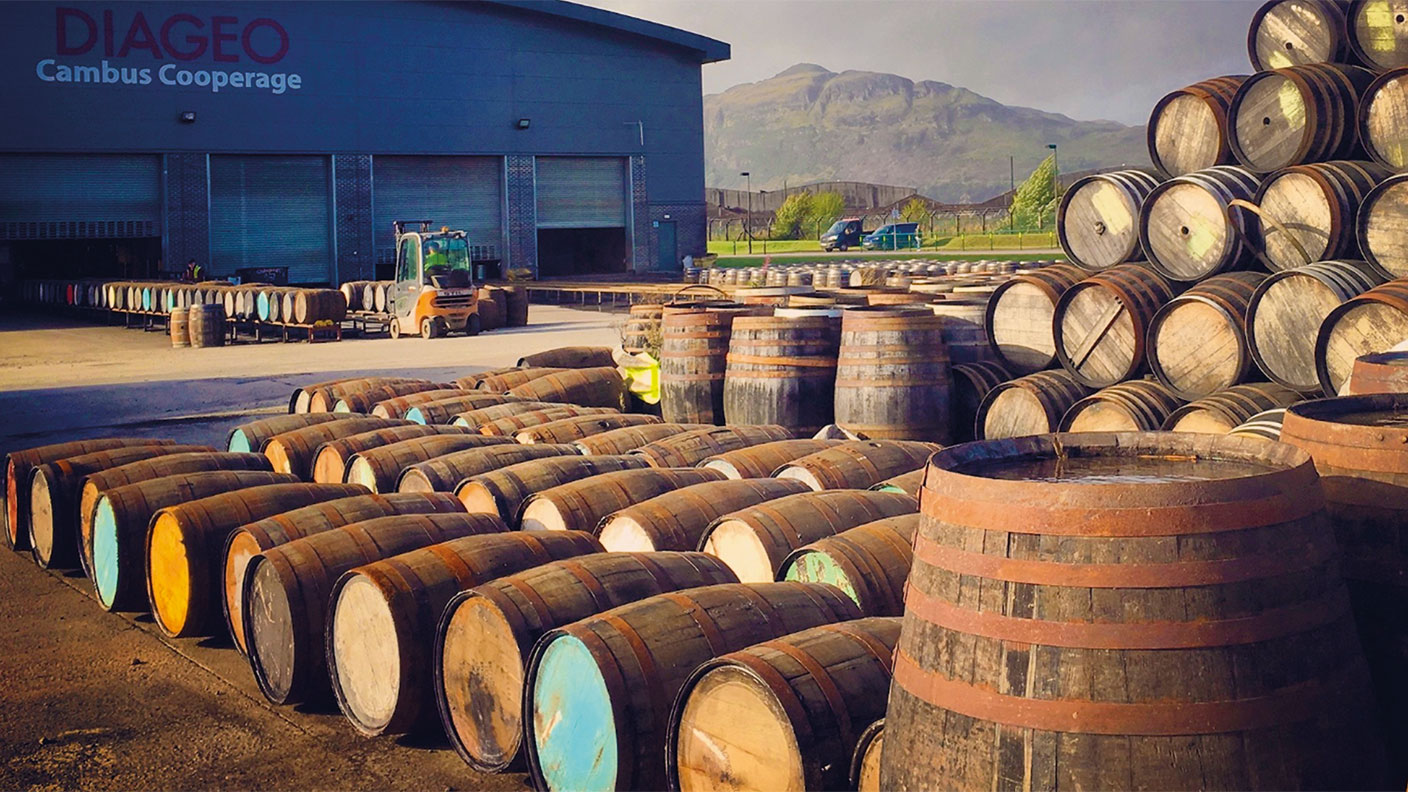How to build your small-cap stock portfolio
David Thornton outlines his simple rules for how private small-cap investors can manage their portfolio.
How many shares do you need to have a sound portfolio? I'll let you in on a secret – it's fewer than you might think.
If you took a portfolio of ten small-cap stocks to a professional financial advisor or fund manager he would tell you that it's too small that you're taking on too much risk. But the reality is that a portfolio of ten shares will stand you in perfectly good stead. Adding a lot more shares than that won't make any difference to your risk.
Limit the number of small-cap stocks you own
The risk level of your portfolio in other words, the extent to which it is likely to fluctuate in value from one day to the next (its volatility, in the City jargon) is determined by a number of factors.
MoneyWeek
Subscribe to MoneyWeek today and get your first six magazine issues absolutely FREE

Sign up to Money Morning
Don't miss the latest investment and personal finances news, market analysis, plus money-saving tips with our free twice-daily newsletter
Don't miss the latest investment and personal finances news, market analysis, plus money-saving tips with our free twice-daily newsletter
The number of shares you own is one important consideration. But you'll also need to think about how much the shares swing around (individual volatility), and the extent to which they tend to move in the same direction at the same time (how correlated' they are).
Without getting bogged down in the maths, all of these elements multiply up to a measure known as the standard deviation' of your portfolio. This is a gauge of its expected volatility.
Let's imagine you have one share with a standard deviation of 25. If you add another share, in a different sector, this figure falls to 20.2.With five shares it shrinks to 16.6. By the time you have ten, the standard deviation of your portfolio drops to just 15.2. That sounds like a big shift. So why not add more and drop the standard deviation even further?
Well, I'll tell you why. Because as you add more and more small-cap stocks, they have less and less impact. Believe it or not, if you have 100 shares, the standard deviation falls to only 13.9. Double that number to 200 shares, and the figure falls to wait for it 13.8.
The crux of the matter is that after a certain point, adding new shares to your portfolio makes practically no difference to its risk at least, risk as defined by the volatility of your portfolio.
But it's important to be sensible about this. You don't need a big long list of stocks, but one thing that will make a difference is making sure you have a good mix. Basically, avoid putting all your eggs in one basket by buying ten shares in the same sector for instance, ten gold mines or biotech companies. That's asking for trouble.
If you stick to this golden rule, then ten shares will be enough. You can add a few more if you want to but do try to limit yourself to 25 or 30 at the most. Buying more won't get you anything extra, apart perhaps from a bunch of dealing costs. And realistically, there are only so many stocks one person can monitor properly.
Of course, if you hold ten shares in your portfolio and one of them halves in value, you lose 5% of your money. But it also works the other way around it means that your winners really make a significant difference.
This isn't how professionals manage money, of course. City fund managers will typically have between 70 and 120 shares in their portfolios. Even if they run a concentrated portfolio' one which is meant to only hold their best ideas', the small-cap stocks in which they have maximum conviction' it will probably hold roughly 40 shares. And I think that's still far too many. (City managers do this because most of them have to worry about tracking an underlying benchmark as well as making money. Their jobs are at risk if they don't, so having lots of stocks helps them to hug' the benchmark, even if it's not the best thing for their clients ultimately).
So the first rule of sound portfolio management is to keep your total number of shares low. I would aim for something between ten and 30.
Spread the risk
I've already mentioned this, but I'm going to mention it again because it's important the other key is to spread your risk across different industries or sectors. No one sector performs consistently each will experience cycles of peaks and troughs.
Look back to the start of the 2000s for example. Technology shares did very badly, while mining shares outperformed the market. However, in recent years, the fortunes of these two have switched around.
To minimise the volatility of your portfolio, make sure that your shares aren't pigeon-holed too narrowly.
Don't over-spend on trading
Here's another absolutely vital tip: keep your investment costs low. The good news is you're already on the right track, by making the decision to bypass the fund management industry and take your investing into your own hands.
But you must also make sure that you don't run up any unnecessary dealing costs. Whenever you buy or sell a share, it will cost you in dealing charges. And these will add up significantly over time (which is another good reason to keep the number of shares you own relatively low).
These tables show you just how much those costs can add up:
| Small-cap stock portfolio size: £5,000 | |||
| Annual turnover | Number of shareholdings | ||
| 5 | 10 | 15 | |
| 20% | £29 (0.6%) | £53 (1.1%) | £77 (1.5%) |
| 50% | £72.50 (1.4%) | £132.50 (2.6%) | £192.50 (3.8%) |
| Small-cap stock portfolio size: £25,000 | |||
| Annual turnover | Number of shareholdings | ||
| 5 | 10 | 15 | |
| 20% | £73 (0.3%) | £97(0.4%) | £121 (0.5%) |
| 50% | £182.50 (0.7%) | £242.50 (1.0%) | £302.50 (1.2%) |
| 100% | £365(1.5%) | £485 (1.9%) | £605 (2.4%) |
| Small-cap stock portfolio size: £100,000 | |||
| Annual turnover | Number of shareholdings | ||
| 5 | 10 | 15 | |
| 20% | £148 (0.1%) | £196 (0.2%) | £292 (0.3%) |
| 50% | £370 (0.4%) | £490 (0.5%) | £730 (0.7%) |
| 100% | £740 (0.7%) | £980 (1.0%) | £1,460 (1.5%) |
Each table shows the total annual dealing costs (including stamp duty), based on an assumed number of individual shareholdings and annual turnover. If annual turnover is shown at 20%, this means that on average/, 20% of your holdings are sold each year and replaced by others. The figures in brackets show the percentage of the total portfolio value that is lost through dealing charges (assuming a £12 a trade dealing cost).
Let's start by analysing the first example in the first table. If you have a portfolio of £5,000 split between five shares, and an annual portfolio turnover of 20% (meaning you sell just one share and replace it with another), the annual cost of running your portfolio is 0.6% of its total value.
That's a huge saving on the amount you'd pay a City professional to manage your portfolio, which would cost about 2.5% a year once you factor in all the costs. In fact, of the 27 theoretical scenarios above, in only five does the annual charge exceed 2.5%.
These might sound like relatively small amounts, but if you're careful to undercut the City you'll see a huge difference over time.
An investment of £10,000, which earns an underlying return of 10% over 20 years, will grow to just over £40,500 after annual charges of 2.5%. But by taking a DIY approach and limiting the annual charges to just 1.5%, you would end up with a pot worth just under £50,000. That's a benefit of almost £10,000 simply from managing your own portfolio!
Rebalance your small-cap stocks portfolio regularly
As soon as you begin investing in the stock market, the size and shape of your portfolio will begin to change. Let's say, for example, that you start by picking ten shares and are equally hopeful about all of them. You could invest the same amount into each.
But if one of those ten small-cap stocks doubles in value while the rest hold still, the proportion of that share in the portfolio will have grown from 10% to 18%.
There's no golden rule as to what to do here some investors will trust their instincts, while others will rebalance their portfolios. The key question to ask yourself in this situation is as far as I'm concerned if I was starting from scratch, would I be happy to have nearly twice as much in this stock as in any of the others I own? If the answer is a genuine yes', then stick with it.
However, it's generally wise not to let your portfolio become too dependent on any one single share. Taking some profit while retaining a good sized holding is a prudent course, and it also leaves you with funds to invest as and when new opportunities come along.
Watch your portfolio but don't get obsessive
It's always a good thing to stay on top of stock market developments. But if you're not careful, this can lead to over-trading. You don't want to be glued to your smartphone or the 24-hour rolling financial news channels. That's just stressful and means you're more likely to make stupid decisions.
I recommend reviewing your small-cap stocks portfolio once a quarter so take a good, hard look at it every three months. Of course, that doesn't mean that you should rest on your laurels between those review dates. If you spot a brilliant opportunity to buy or sell, make the most of it.
Look at the review process as an academic study. If you have a portfolio with an online broker, take the time to print it out. Sit down, and have a thorough read through.
Ask yourself these key questions: Are you holding too few small-cap stocks or too many? Have some of the holdings shrunk to a size that renders them insignificant? Are you holding any shares which seemed a good idea when you bought them but are now in the portfolio more in hope than confidence? Do you have a good spread of shares across diverse sectors?
You might decide that your portfolio is looking good. Perhaps you'll want to tweak a couple of holdings. But the most important thing is that you keep an eye on what's happening. Monitor your investments closely, and stay in control.
Get the latest financial news, insights and expert analysis from our award-winning MoneyWeek team, to help you understand what really matters when it comes to your finances.
David Thornton is a small cap share expert with over 30 years’ experience in the investment world. He was an equity fund manager at Henderson Global Investors for 17 years, and in 2006 he launched the Matrix New Europe Fund, investing in equities throughout Eastern Europe, Russia and Turkey.
-
 ‘Why I have ditched my Help to Buy ISA for cash savings and the stock market’
‘Why I have ditched my Help to Buy ISA for cash savings and the stock market’Without the 25% bonus, my Help to Buy ISA is effectively redundant, says MoneyWeek writer Sam Walker.
-
 Is your inheritance tax allowance cut if you sell to downsize or sell your home to pay for care?
Is your inheritance tax allowance cut if you sell to downsize or sell your home to pay for care?Downsizing relief is a little-known benefit that could save your loved ones tens of thousands of pounds in inheritance tax after you’ve died.
-
 The nifty nine: a portfolio of stocks to buy and hold forever
The nifty nine: a portfolio of stocks to buy and hold foreverCover Story A diverse range of stocks you can buy and keep forever should be a core part of any equity portfolio, says Dr Mike Tubbs. He selects his nine favourites from sectors ranging from agriculture to scientific instruments.
-
MoneyWeek ETF portfolio update: taking a lesson on inflation from the 1970s
Tips Inflation is here to stay. Time to protect our ETF portfolio with some energy exposure, says Cris Sholto Heaton
-
 Build a global portfolio: where to look for growth and value now
Build a global portfolio: where to look for growth and value nowCover Story The Covid-19 crisis and ongoing jitters over world trade have left emerging markets unusually cheap – yet their long-term growth prospects remain compelling. It’s time to buy, says Matthew Partridge
-
 How to build a secure income portfolio
How to build a secure income portfolioCover Story The Covid-19 crisis has been a huge test for income portfolios, with global dividends slashed on a scale unprecedented for more than 70 years. Cris Sholto Heaton looks at some of the lessons so far.
-
How to construct an all-weather ETF portfolio
Advice The outlook for markets is highly uncertain. This set of investments balances growth with protection in a crisis, says Cris Sholto Heaton
-
The Kids’ Portfolio: Four top funds to buy for your children
Features Having 40 years to invest can free you up to take risks in the big themes of the next few decades, says David C Stevenson. Here, he picks four of the best funds to buy for the long term.
-
What’s a portfolio, and how do you build one?
Tutorials Not putting all your eggs in one basket is one of the oldest pieces of investment advice. So how do you start to build your portfolio, and what should you buy? John Stepek explains.